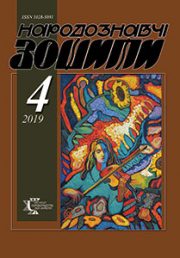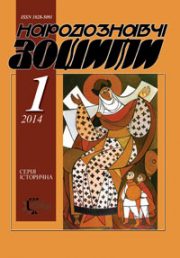The Ethnology Notebooks. 2020. № 3 (153), 585—593
UDK 398((477+478)-04)
DOI https://doi.org/10.15407/nz2020.03.585
PASTUKH Nadiia
ORCID ID: https://orcid.org/0000-0001-7703-5541
Candidate of Philological Sciences (Ph. D. in Philology),
Senior Researcher at the Ethnology Institute
of the National Academy of Sciences of Ukraine,
15, Svobody Avenue, 79000, Lviv, Ukraine.
Contacts: е-mail: npastukh@gmail.com
Abstract. Folklore culture as a segment that brightly presents ethnic specificity (researchers attribute the folklore tradition to the main markers of ethnic identification) is a particularly grateful material for presenting the uniqueness of ethnic culture creation in the marginal territories in the context of cultural coexistence of ethnic groups. Therefore, the consideration of the peculiarity of the Ukrainian folklore tradition of a certain defined border (namely, zones of ethnic contacts between Ukrainians and Moldovans along the line of border) becomes especially relevant in the context of the typological regularities of folklore in zones of ethno-cultural boundaries. In the article we aim to find out the peculiarity of Ukrainian folklore creation on the territory of the Ukrainian-Moldovan border in the light of the general patterns of folklore functioning in the areas of ethno-cultural boundaries. Achieving this goal has inevitably led to a number of other, equally pressing, issues. Thus, along with the definition of “borderline” markers of the folklore tradition, the substrate of such a tradition was clearly manifested and the changing segment was objectified, as well as in particular the distinct functions of folklore were appeared on the background of multi-ethnic cultural interaction. The object of the study is the folklore tradition in the variety of genres and texts that occur in the Ukrainian villages of Moldova, and the subject is the levels at which the borderline specificity of the folklore tradition is motivated and the factors that determine such specificity. The combination of methods of local and regional research with the techniques of comparative studies determines the basis of the research view of the problem. The research was conducted mainly on the basis of the materials of folklore records that were carried out in 43 villages and 1 city of 10 districts of the Republic of Moldova (in places of compact residence of Ukrainians) during integrated scientific expeditions of the Institute of Ethnology of the National Academy of Sciences of Ukraine (2005—2007) and personal expeditions (2008—2009, 2016).
Keywords: folklore tradition, Ukrainian-Moldovan borderland, folk genre system, conservation, thematic priorities.
Received 19.05.2020
REFERENCES
Paladi-Kovach, A. (2005). Notes on Ethnographic Interpretation of Zone and Zonal Concepts. In Ethnic Contact Point in the Carpathian Basin in the Second Half of the 20th entury (Pp. 8—10). As cited in Mushketyk, L. (2013). Folklore of the Ukrainian-Hungarian Borderland. Kyiv: Ukrainian writer [in Ukrainian].
Zelenchuk, V.S. (1979). The Population of Bessarabia and the Dniester Region in the XIX century (Ethnic and Socio-Demographic Processes). Сhisinau: Moldavian SSR Academy of Sciences; Department of Ethnography and Art [in Russian].
Kushner, P.I. (1951). Ethnic Territories and Ethnic Borders. Moscow [in Russian].
Bojechko, V., Hanzha, O. & Zakharchuk, B. (1994). The Boundaries of Ukraine: Historical Retrospect and Current Status. Kyiv [in Ukrainian].
Padjuka, N. (2008). Beginnings of Ukrainian Ethnocartography (Second Half of the XIXth c.). Proceedings of Vasil Stefanyk National Scientific Library of Ukraine in Lviv, 1 (16), 435—458 [in Ukrainian].
Chubynskyi, P.P. (Ed.). (1877). Works of the Ethnographic-Statistical Expedition in the West Russian Regions, Organized by The Imperial Russian Geographical Society: in 7 vol. (Vol. VII). Jews. Poles. Tribes of Other than Malorussian (Ukrainian) Origin. Malorussy (Ukrainians) (Statistics, Rural Life, Language). St. Petersburg: K.V. Trubnikov Publ. [in Russian].
Afanas’ev-Chuzhbinskiy, A.S. (1893). Trip to Southern Russia. Essays of the Dniester. In Bykov (Ed.), A.S. Afanas’ev-Chuzhbinskiy. The Collected Works (Vol. 8). St. Petersburg: Book Publishing House «Hermann Goppe» [in Russian].
Berg, L.S. (1923). The Population of Bessarabia. Ethnographic Composition and Number. Petrograd [in Russian].
Balabushevych, T.A. (2004). Formation and Development of Ethnic Boundaries of Ukrainians. Magisterium, 17, 69—74 [in Ukrainian].
Bostan, H.K. (1987). Moldovan-Russian-Ukrainian Interconnections of Contact Zones (in the Context of Historical Relatedness of Oral-Poetic Traditions). The Thesis for the Academic Degree of Doctor of Philological Sciences with a Specialization in Folkloristic. Moscow [in Russian].
Demographic, National, Languistic and Cultural Characteristics (2006). In Population Census, 2004. Сhisinau [in Romanian, in Russian].
Tolstoy, N.I. (1977). Correlation between Central and Marginal Areas in Modern Slavia. In Area Studies in Linguistics and Ethnography (Pp. 37—56). Leningrad [in Russian].
Nesterovskii, P.A. (1910). In the North of Bessarabia. Travel Essays. Warsaw [in Russian].
Grytsa, S.V. (1992). Migrations of Folklore. In Ukrainian Folklore Outside Ukraine. Сollection of Scientific Works (Pp. 20—40). Kyiv [in Ukrainian].
Tatarenko, T. (2004). Ethnic Borders and Interethnic Tolerance. Political Management, 5, 31—39 [in Ukrainian].
Kurochkin, O. (1995). Ukrainian New Year Rites: «A Goat» and «Malanka» (from the History of Folk Masks). Opishne [in Ukrainian].
Moysey, A. (2008). Magic and Mantic in the People’s Calendar of the East Romanian Population of Bucovina. Chernivtsi: Druk Art [in Ukrainian].
Pastukh, N. (2014). On Ukrainians’ Genre System of Ukrainian-Moldovan Borderland in the Context of Frontier Typology. The Ethnology Notebooks, 3 (117), 529—544 [in Ukrainian].
Pastukh, N. (2018). Pluvial Practices in the Ukrainian Villages of Ukrainian-Moldovan Borderlands: the «Doll’s Funeral» Rite and Lamentation that Accompany it. The Ethnology Notebooks, 6 (144), 1456—1478 [in Ukrainian].
Kharchyshyn, O.M. (2005). Folklore of the Ukrainians of Moldova. Archive of the IN NANU (Archive of the Institute of Ethnology of the National Academy of Sciences of Ukraine). F. 1. Op. 2. Od. save 524. Arc. 1—92 [in Ukrainian].
Pastukh, N. (2018). Heykannya in the Folklore Tradition of Ukrainians of the Ukrainian-Moldovan Borderlands. In Odessa Ethnographic Reading: The Ukrainian Frontier: Variability in Traditional Culture. Сollection of Scientific Works (Pp. 271—279). Odesa [in Ukrainian].
Pastukh, N. (2010). Wedding Ceremonial Rites and Accompanying Songs of the Ukrainians in Northern Moldova. Mythology and Folklore, 2 (6), 26—36 [in Ukrainian].
Kyrchiv, R.F. (2002). From Folklore Regions of Ukraine. Essays and Articles. Lviv: Ethnology Institute of National Academy of Sciences of Ukraine [in Ukrainian].
Pastukh, N. (2015). On Some Markers of the Borderland Specificity in Folklore: Thematic Priorities of Ukrainian Oral Narratives in Northern Moldova. The Ethnology Notebooks, 2 (122), 364—369 [in Ukrainian].
Pastukh, N. (2015). Markers of the Frontier Folklore: Strangers in the Folklore of the Ukrainian-Moldovan Borderlands. In Odessa Ethnographic Reading: Ethno-Cultural Processes of the Ukrainian-Eastern Roman Borderland. Сollection of Scientific Works (Pp. 206—220). Odesa [in Ukrainian].
Konieva, Ya. (1999). The Symbolic Space of «One’s Own Land» in the Folklore of the Borderland. In Traditional Ethnic Culture of the Slavs. Сollection of Scientific Works (Pp. 36—37). Kyiv [in Ukrainian].
Belova, O.V. (2005). Ethnocultural Stereotypes in the Slavic Folk Tradition. Moscow: Indrik [in Russian].







